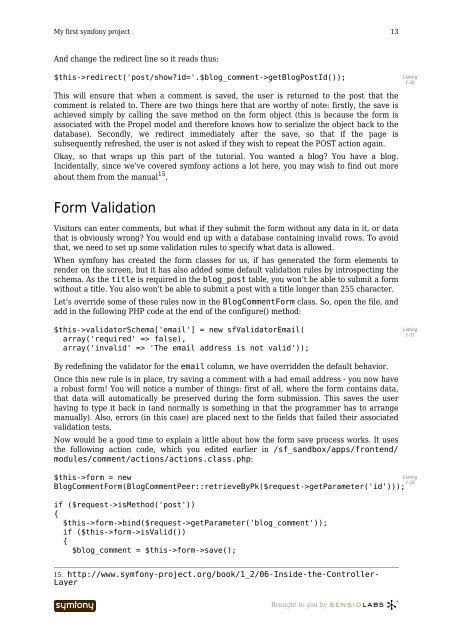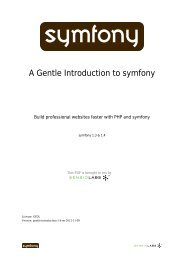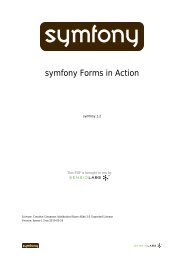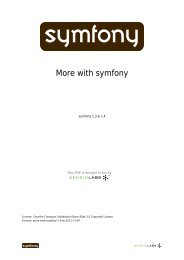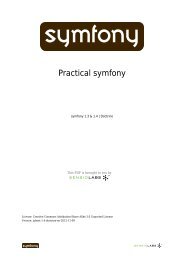My first symfony project - Mesurex
My first symfony project - Mesurex
My first symfony project - Mesurex
- No tags were found...
Create successful ePaper yourself
Turn your PDF publications into a flip-book with our unique Google optimized e-Paper software.
<strong>My</strong> <strong>first</strong> <strong>symfony</strong> <strong>project</strong> 13And change the redirect line so it reads thus:$this->redirect('post/show?id='.$blog_comment->getBlogPostId());Listing1-30This will ensure that when a comment is saved, the user is returned to the post that thecomment is related to. There are two things here that are worthy of note: <strong>first</strong>ly, the save isachieved simply by calling the save method on the form object (this is because the form isassociated with the Propel model and therefore knows how to serialize the object back to thedatabase). Secondly, we redirect immediately after the save, so that if the page issubsequently refreshed, the user is not asked if they wish to repeat the POST action again.Okay, so that wraps up this part of the tutorial. You wanted a blog? You have a blog.Incidentally, since we’ve covered <strong>symfony</strong> actions a lot here, you may wish to find out moreabout them from the manual 15 .Form ValidationVisitors can enter comments, but what if they submit the form without any data in it, or datathat is obviously wrong? You would end up with a database containing invalid rows. To avoidthat, we need to set up some validation rules to specify what data is allowed.When <strong>symfony</strong> has created the form classes for us, if has generated the form elements torender on the screen, but it has also added some default validation rules by introspecting theschema. As the title is required in the blog_post table, you won’t be able to submit a formwithout a title. You also won’t be able to submit a post with a title longer than 255 character.Let’s override some of these rules now in the BlogCommentForm class. So, open the file, andadd in the following PHP code at the end of the configure() method:$this->validatorSchema['email'] = new sfValidatorEmail(array('required' => false),array('invalid' => 'The email address is not valid'));Listing1-31By redefining the validator for the email column, we have overridden the default behavior.Once this new rule is in place, try saving a comment with a bad email address - you now havea robust form! You will notice a number of things: <strong>first</strong> of all, where the form contains data,that data will automatically be preserved during the form submission. This saves the userhaving to type it back in (and normally is something in that the programmer has to arrangemanually). Also, errors (in this case) are placed next to the fields that failed their associatedvalidation tests.Now would be a good time to explain a little about how the form save process works. It usesthe following action code, which you edited earlier in /sf_sandbox/apps/frontend/modules/comment/actions/actions.class.php:$this->form = newBlogCommentForm(BlogCommentPeer::retrieveByPk($request->getParameter('id')));if ($request->isMethod('post')){$this->form->bind($request->getParameter('blog_comment'));if ($this->form->isValid()){$blog_comment = $this->form->save();Listing1-3215. http://www.<strong>symfony</strong>-<strong>project</strong>.org/book/1_2/06-Inside-the-Controller-Layer----------------- Brought to you by


